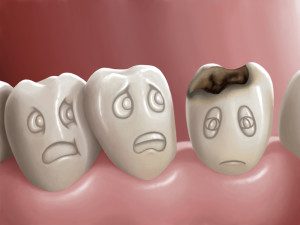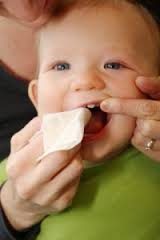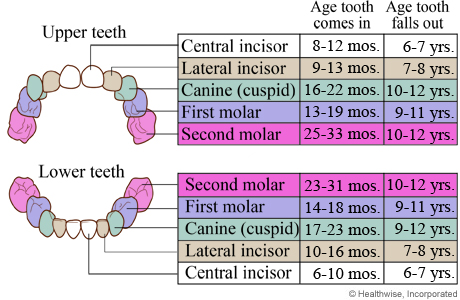Baby Teeth
After weeks of watching your baby drool and fuss, you finally spot that first little tooth popping up through the gums. Over the next couple of years, your baby’s gummy smile will gradually be replaced by two rows of baby teeth.
Baby teeth may be small, but they’re important. They act as placeholders for adult teeth. Without a healthy set of baby teeth, your child will have trouble chewing and speaking clearly. That’s why caring for baby teeth and keeping them decay-free is so important.
Caring for Baby Gums
You can start caring for baby’s gums right away. But at first, the care won’t involve a toothbrush and toothpaste. Instead, take these steps:
- Gently wipe down your baby’s gums at least twice a day.
- Especially wipe your baby’s gums after feedings and before bedtime.
This will wash off bacteria and prevent them from clinging to gums. Bacteria can leave behind a sticky plaque that damages infant teeth as they come in.
Tooth decay — brown or white spots or pits on the teeth. If you notice this bring your child into our office for an exam.
Even if there isn’t a problem, your child should go for his or her first dental visit by age one. We can give you advice about:
- baby tooth care
- teething
- fluoride
- thumb sucking
Teething
It can take two years before all of the infant teeth have made their way through your baby’s gums. The process as each tooth emerges is called “teething.” It can be a trying time for you and your baby.

Teething is uncomfortable. That’s why your baby cries and fusses in the days or weeks before each baby tooth pops up. Babies can display other teething symptoms, too, including:
- drooling
- swollen gums
- slightly higher than normal temperature
Here are a few tips to relieve your baby’s teething pain:
Teething rings. Let your baby chew on a clean, cool teething ring or cold washcloth. Just avoid giving your child anything that is small enough to choke on. Also avoid a teething ring with liquid inside that could break open.
Gum rubbing. Rub your baby’s gums with a clean finger.
Pain relief. Topical pain relievers rubbed on the gums should not be used for teething. Not only does saliva quickly wash the medication away, but the FDA warns against dangerous, potentially life-threatening side effects caused by such products. Give your baby Tylenol (acetaminophen) occasionally to relieve pain. Never give your child aspirin. It has been linked with a rare but serious condition called Reye’s syndrome in children.
If your baby is unusually irritable or inconsolable, call our office.
Tooth Timing
Most babies get new teeth and lose their teeth at expected times. The exact order and timing may vary. See the chart below.
Cavities
Cavities are what you get from tooth decay — damage to the tooth. Tooth decay can affect both the outer coating of a tooth (called enamel) and the inner layer (called dentin).

What causes decay? When foods with carbohydrates like bread, cereal, milk, soda, fruit, cake, or candy stay on your teeth. The bacteria in your mouth turn them into acids. The bacteria, acid, food debris, and your saliva combine to form plaque, which clings to the teeth. The acids in plaque dissolve the enamel, creating holes called cavities.
Symptoms
There are often no symptoms of cavities, which is why visiting a dentist and having radiographs taken periodically are important so that cavities can be diagnosed and treated early before they get large enough to cause symptoms. The most common early symptoms of cavities are a “chalky white or discolored spot on a tooth” and “sensitivity to cold.”
As the cavity progresses, the decay gets near the nerve (pulp) and can cause pain, which gets progressively worse especially with exposure to heat, cold, sweet foods or drinks. If the decay gets large enough, part of the tooth may fracture off, leaving a large visible hole, and the tooth may be sensitive to biting pressure. Bad breath and or a bad taste in the mouth are also symptoms.
Cavities on the front teeth are the easiest to see and will look like a brown or black spot. Cavities in other parts of the mouth are often not visible without an X-ray.
Detection
A dentist can detect a cavity by using a sharp instrument to feel tooth structure that has been softened by tooth decay. If a cavity forms in between the teeth, it may only be visible on an X-ray. Regular dental exams are recommended so cavities can be diagnosed when they are small cavities (incipient caries) instead of waiting until they grow large enough to produce pain and require more extensive treatment.
Treatment
White/Composite Fillings Made of tooth-colored material, composite fillings restore the teeth’s natural beauty. Composite fillings can be matched very closely to your child’s natural tooth color and are virtually indistinguishable from non-restored teeth. Composite fillings are excellent options for front teeth, but may be suggested for selected sites on molars as well. The composites we use have proven to be extremely durable and stain resistant.
Crown A crown is a restoration that covers a tooth in order to strengthen it as well to restore it to its normal shape and size. A crown may be placed to support a large filling when there is little remaining tooth structure. A tooth that has been treated with pulp therapy will require a crown to provide strength and support to the tooth. Stainless steel crowns are typically used on primary teeth. Recommendations will be discussed in detail during the examination/consultation appointment.
Nerve Treatment When the nerve or pulp tissue of a primary or permanent tooth is affected by a large cavity, it needs to be treated to prevent a dental abscess or loss of the tooth. The two methods of treating affected dental nerve tissue are the pulpotomy and pulpectomy. The ultimate objective of these procedures is to save the tooth, so that it will maintain the integrity and function of the dental arch.










